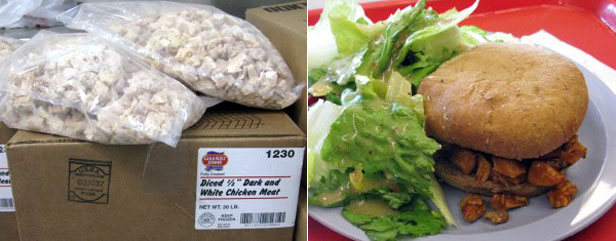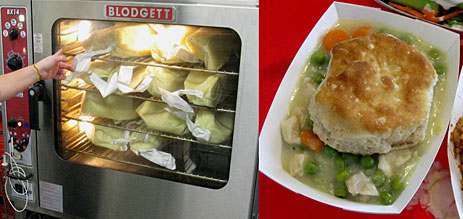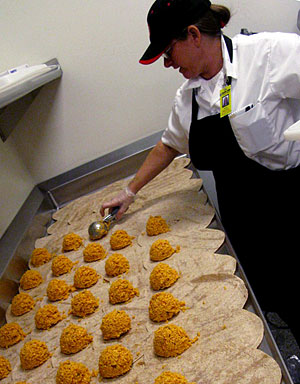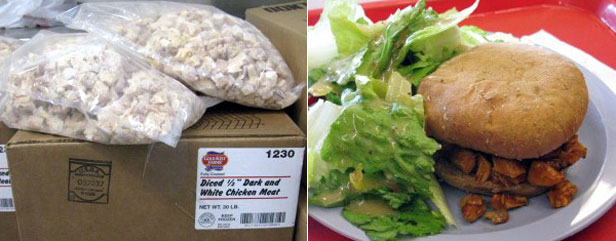Intrepid school-lunch reporter and parent-turned-school-food-activist Ed Bruske has hit the road again, this time traveling to Boulder, Colo. Check out Ed’s previous reporting on Washington, D.C. and Berkeley, Calif. public schools’ food at the Cafeteria Confidential: Behind the Scenes in School Kitchens series homepage.
 Creative commodity marketing: Bags of frozen diced chicken become a barbecue chicken sandwich.Photos: Ed Bruske
Creative commodity marketing: Bags of frozen diced chicken become a barbecue chicken sandwich.Photos: Ed Bruske
Ann Cooper warned me that I might see some unusual things in the school kitchens on my visit to Boulder. I did.
One morning at Casey Middle School, five-pound bags of what looked like frozen cookie dough lay on a stainless-steel work table. In fact, labels described the contents as chicken gravy. Not your typical institutional gravy, processed in some distant factory with 50 industrial additives, however. No, this chicken gravy — destined to make hundreds of portions of chicken pot pie for Boulder school children — was made according to Cooper’s precise instructions, by a family-owned company less than an hour away in Denver.
Ready Foods, established in 1972 with Mexican cuisine in mind, now specializes in custom-formulated “kettle” products for restaurant chains, meaning just about anything that can be cooked in a 200-gallon commercial kettle. Chinese, Italian, Mexican — Ready Foods covers it all, says owner Marco Abarca. Yet until Ann Cooper came along, he had never considered schools as a potential customer.
“I always thought school business was something I would never go after because it’s so heavily bureaucratic,” Abarca said. “It seems to be all about low quality, low price. And that’s not something I want to be in.”
Gravy train
 Frozen bags of chicken gravy become chicken pot pie.
Frozen bags of chicken gravy become chicken pot pie.
For Cooper, who is all about cooking school food from whole ingredients without the additives, Ready Foods was a perfect fit. She could tell Abarca exactly what she wanted in her chicken gravy — known as veloute in chef circles — meaning none of those emulsifiers, stabilizers, flavor-enhancers, and preservatives whose names you can’t pronounce. After visiting the factory with her business partner, Beth Collins, she now sends Abarca the government commodity beef she earns from selling meals in the National School Lunch Program to turn into chili and taco filling. In his 85,000-square-foot food factory, Abarca makes the béchamel sauce for Boulder schools’ macaroni and cheese.
What’s happening in Boulder offers a rare glimpse into the carefully choreographed steps that must be taken to accomplish radical change in a large school district’s food service. Cooper has unveiled an all-new menu and hired a new staff of professional chefs and kitchen managers to cook meals in five newly outfitted production kitchens. While the cooks get their legs in the new digs, Cooper devises ways to remain true to her belief in unadulterated food.
It’s a work in progress, and the details are almost unfathomably complex.
Cooper puts out 10,000 meals a day — 2,500 breakfasts and 7,500 lunches — and despite the difficulties of implementing so many changes in a relatively short period of time, and the many products she’s outsourced rather than cooking from scratch, she’s managed to keep ingredient costs to $1.13 per meal, not terribly higher than the national average of around $1.
Cooper has to write her school menu for the entire year months in advance. The commodity food products she uses — beef, chicken, pasta, cheese, beans — must be ordered from the federal government a year ahead of time. To coordinate ingredients, menus, and production details, Cooper and Collins create a giant Excel spreadsheet listing menu items and recipes Collins has devised that can “explode” from a basic formula into servings for thousands of kids.
They then examine each day’s menu and calculate how the meals will be assembled, and what staff and equipment will be required. For instance, a roast chicken thigh on the menu means the production kitchens will need sheet pans on which to cook the thighs and ship them to outlying schools. How many thighs fit on a sheet pan? How many sheet pans are needed? How many sheet pans fit on the rolling racks the kitchens use to transport the roasted thighs? And how many rolling racks will fit on one of Cooper’s delivery trucks?
All of that might affect the next day’s menu selection as well: There could be a problem if sheet pans were needed again and they haven’t been returned from the schools to the production kitchens.
“It’s not just about how to cook the chicken. Without some kind of owners manual, it’s really hard to figure out how to do it. Unless you have a very strong background, it’s very hard to get your arms around all these pieces,” said Cooper.
One of Cooper’s district managers, Brandy Dreibelbis, scans the menus and the recipes and writes the “prep lists” — the work that needs to be done on any given day — for all five of the system’s production kitchens for an entire month. Cooper wants to know that all of her production cooks are doing the same thing on any given day. Anything she can do to streamline and economize will potentially save money that can be used to improve the quality of the meals she serves. It also takes some of the pressure off her employees, who are still getting used to the new system in Boulder.
In Berkeley, where Cooper also revamped the school meal service, the central kitchen makes something I call “epic chicken,” meaning the 1,400 pounds of chicken parts that arrive courtesy of the federal government frozen in 40-pound blocks. They require days — and quite a bit of room in the central kitchen facility — to defrost, marinate, sort, roast, package, and ship to the district’s schools.
In Boulder, Cooper eliminates some of the hassle by buying commercially prepared chicken thighs that are quick-frozen individually so they can easily be poured out of a bag and placed on a roasting pan, a method she wishes the USDA would adopt.
Those chicken thighs taste awfully good next to a side of freshly mashed potatoes. I was also taken with a barbecued chicken sandwich made with diced chicken that arrives cooked and frozen from Gold Kist Farms. In fact, frozen foods show up in some surprising places. The frozen corn on the salad bar is nothing new, nor are the frozen peas. But would you believe frozen hard-boiled eggs to spoon over your salad? If one of the cooks hadn’t told me, I would never have known.
Cooper puts out 10,000 meals a day — 2,500 breakfasts and 7,500 lunches — and despite the difficulties of implementing so many changes in a relatively short period of time, and the many products she’s outsourced rather than cooking from scratch, she’s managed to keep ingredient costs to $1.13 per meal, not terribly higher than the national average of around $1.
“That’s a testament to Beth’s ability at procurement, but also testament to our ability to manage
waste and product,” Cooper said. “It’s a big, big job. People say, ‘God, you have so many managers!’ But you have to have managers to manage all your costs. We’re spending a couple million dollars on food, so we have to manage it correctly.”
Chocolate syrup smugglers
Kids, meanwhile, don’t care about management, and they may still need some convincing where healthier foods are concerned. They’re nostalgic for the good old days of processed convenience foods. They miss their chicken nuggets and Subway sandwiches and even the miniature pancakes that were served reheated inside their plastic packaging. A Boulder lunch menu from April 2005 lists macaroni and cheese, hamburgers, hot dogs, mini-pancakes with sausage, and the ever-popular pizza. There were chicken nuggets, nachos, a beef rib sandwich, cheese sticks, and a soft pretzel with cheese sauce. They still talk about the “French toast sticks” that were served as a lunch item.
 One morning I helped stuff 800 of these quesadillas.“On Friday, I saw 10 kids with microwavable meals in the cafeteria,” said Michelle Hancock, a production cook at Casey Middle School. And since the schools serve only plain, low-fat organic milk from dispensers under Cooper — no more cartons of chocolate or strawberry — some kids bring their own chocolate syrup from home to squeeze into the milk, Hancock said.
One morning I helped stuff 800 of these quesadillas.“On Friday, I saw 10 kids with microwavable meals in the cafeteria,” said Michelle Hancock, a production cook at Casey Middle School. And since the schools serve only plain, low-fat organic milk from dispensers under Cooper — no more cartons of chocolate or strawberry — some kids bring their own chocolate syrup from home to squeeze into the milk, Hancock said.
Cooper’s menu contains many kid-friendly items that sound very similar to those on the old menu. But they’ve all been redesigned to be healthier. Hamburgers, for instance, are served on a whole-wheat bun. Pizzas are made in-house using a frozen commercial crust with freshly made sauce. Nachos are made with real grated cheese, not the canned, DayGlo stuff full of industrial additives. Some kids have complained the new food doesn’t have enough flavor. Cooper’s chefs continually tweak the recipes.
“Last year we cheated,” said Margaret Trevarton, the head “lunch lady” — or “kitchen satellite lead” — at Columbine Elementary School. “I was adding spices to the food, like garlic in the macaroni and cheese.”
One morning my assignment was to help stuff 800 cheese quesadillas at Monarch High School. They couldn’t have been simpler. Whole-wheat flour tortillas were laid out on a metal surface. A filling of grated cheddar cheese mixed with tomato salsa had already been mixed in a huge plastic tub. A cook laid a firm scoop of filling on each tortilla and I followed, spreading the cheese over half the tortilla with my fingers, folding the tortilla in half to cover the cheese. It was pleasant, meditative work. No one was having a heart attack — no barking in this kitchen.
For November, the Boulder menu called for nachos, pizza, chicken pot pie, pasta Bolognese, roast chicken, tacos, hots dogs, and a shepherd’s pie that so far has failed to light a spark in the student population. As the staff settles in, Cooper plans to cook more of the food from scratch. And as cold weather approaches, something new will appear in Boulder’s cafeterias: hot soup.
Cooper needs approximately an additional 1,000 kids to eat the meals district-wide to balance a $360,000 deficit in her food service operation. About 5,000 of the kids who regularly participate in the meal program eat free or at a reduced price based on family income. That means Cooper so far is reaching only 15 percent of kids who can afford to buy their own lunch. Here’s the good news: Cooper still has 85 percent of the full-price student population from which to draw the customers she needs. So far this year, Cooper says she’s on target.




